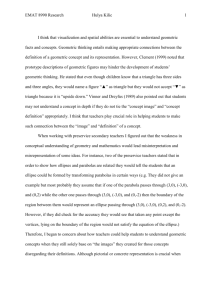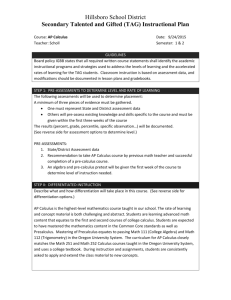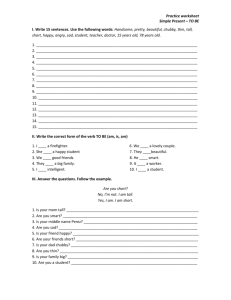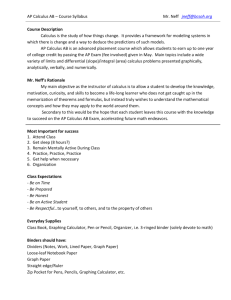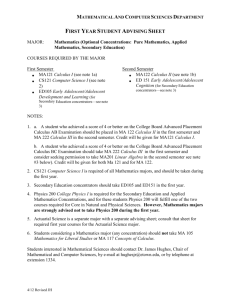Concept Image: Development and Applications to Calculus Courses
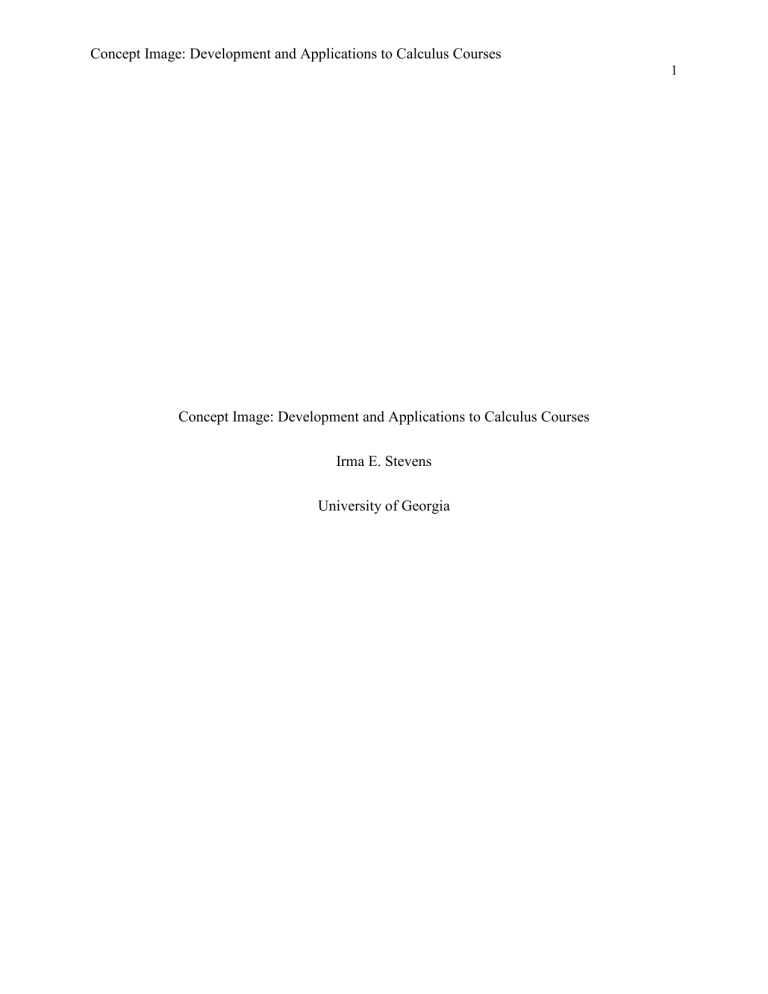
Concept Image: Development and Applications to Calculus Courses
Concept Image: Development and Applications to Calculus Courses
Irma E. Stevens
University of Georgia
1
Concept Image: Development and Applications to Calculus Courses
Concept Image: Development and Applications to Calculus Courses
2
Tall and Vinner developed an idea considering the contrast between concept definition and concept image (1981). This idea became the groundwork for future mathematics education researchers as they endeavored to explain models of students’ mathematical behaviors.
Furthermore, teachers and researchers have applied the idea to examine their students’ work and understand some of the cognitive schemes students were creating. This paper will present the ideas and the application presented by Tall and Vinner, and it will analyze how these ideas have evolved and been applied in various studies on undergraduate Calculus students both inside and outside of the classroom.
What is Concept Image?
Tall and Vinner establish and explain the idea of concept image and other terms associated with it in their 1981 article. The key distinction made is the difference “between the mathematical concepts as formally defined and the cognitive processes by which they are conceived” (Tall & Vinner, 1981, p. 151). The term concept image is defined as “the total cognitive structure that is associated with the concept, which includes all the mental pictures and associated properties and processes” (Tall & Vinner, 1981, p.152). This image also includes all mental attributes associated with a concept. It changes as an individual experiences new stimuli, and the mental images developed may produce future conflict. For instance, a student with the mental image that subtraction reduces may encounter conflict when subtracting negatives numbers.
Furthermore, since different stimuli activate different parts of the concept image, Tall and
Vinner classify the evoked concept image as the portion that is activated at a particular time
(1981, p. 152). When conflicting evoked concept images occur at different times there is no
Concept Image: Development and Applications to Calculus Courses sense of conflict or confusion for the person; however, when conflicting aspects are evoked simultaneously, there is.
Whether constructed personally (personal) or accepted by the mathematical community
(formal), a concept definition is regarded as “a form of words used to specify that concept” (Tall
& Vinner, 1981, p.152). Tall and Vinner connect the ideas of concept image and concept definition by noting that “for each individual a concept definition generates its own concept image” (1981, p.152). Basically, the personal concept definition, if it exists at all for an individual, is part of one’s concept image. Moreover, a student may be able to give a correct formal definition of a concept while holding a conflicting concept image. When part of the
3 concept image or concept definition conflicts with another part of the concept image or concept definition, it is a potential conflict factor . If these factors are evoked simultaneously and cause actual cognitive conflict, they are called cognitive conflict factors (Tall & Vinner, 1981, p. 153).
In order to provide examples of these definitions and how and when they manifest in students, Tall and Vinner present a study done on limits and continuity. It shows how building up concept images and only presenting formal concept definitions at the end of a curriculum may produce certain potential conflicts which can cause cognitive conflict for students later on in their academic careers. The study considers how limits of sequences, limits of functions, and continuous functions taught in The School Mathematics Project Advanced Level (SMP) texts may cause some of these potential conflict factors.
First, the authors discuss limits of sequences. In the SMP curriculum, sequences are typically introduced without a formal definition before the function concept is defined, and then reinterpreted again as part of the function concept (Tall & Vinner, 1981, p.155-156). Only near the end of the course is the convergence of sequences discussed formally. Tall and Vinner define
Concept Image: Development and Applications to Calculus Courses
4 this type of instruction as following the spiral technique: a concept is introduced contextually and subtly built up until a formal definition is presented along with a brief use of it. In an effort to understand what concept image is produced using this technique and whether or not this image contains the formal concept definition, Tall and Vinner provided a questionnaire to mathematics students arriving at a university. One particular potential conflict factor that occurred during these interviews resulted when students were determining whether 0.999… repeated equals to one. The students would answer that 0.999… repeated did not equal to 1 when finding limits but experienced actual cognitive conflict when they wanted to say that 0.999… repeated equals 1 when considering multiplying a third by three (Tall & Vinner, p. 158-159).
Tall and Vinner concluded that the students concept image of limits did not allow the limits of sequences to reach their limits, and that giving students mostly examples in which the formulae do not reach the limit does not help when a student is trying to form the concept image.
Thus, the students experienced cognitive conflict. Furthermore, a weak understanding of the concept definition can make formal proofs difficult. When students have a strong concept image and a weak concept definition image, it typically produces potential conflict factors (1981, Tall and Vinner, p. 159).
As the authors study limits of functions and continuous functions in a similar manner, they come to similar conclusions. When studying limits of functions, students were asked to write a definition for the limit of a function of x equaling c as x approaches a and then asked to explain a given explain of this case. The questionnaire revealed that a majority of students (31 out of 70) presented dynamic (instead of formal) definitions to define a limit and used a dynamic idea to explain the problem. Also, most of the students who presented formal definitions did so incorrectly (14 out of 18). Nevertheless, most of these students who could not give a concept
Concept Image: Development and Applications to Calculus Courses definition could attempt the example using procedural methods. Three of the four students who
5 gave a correct formal definition applied it in the given problems. The majority of the students who gave incorrect formal definitions used dynamic methods, and all the students who gave a dynamic definition used dynamic methods (1981, Tall and Vinner, p. 160-162).
Similarly, students tended to use the idea of a continuous function having no gaps leading to potential conflict factors with the accepted formal concept definition (1981, Tall and Vinner, p. 163-166). These examples reveal some detachment between the formal concept definition and the concept image students have, particularly in regards to their personal concept definition.
How Does Concept Image Help before Class?
Vinner later paired with Dreyfus and continued exploring and studying this idea of concept image and conflict with functions (Vinner & Dreyfus, 1989). The two designed a questionnaire for 271 college students and 36 junior high school teachers in order to determine the cognitive schemes associated with their concepts of a function. Building off the ideas in
Vinner’s previous work (Tall & Vinner, 1981; Vinner, 1983; Vinner & Hershkowitz, 1980),
Vinner noted that students do not necessarily use the definitions introduced to them when determining examples or nonexamples of given mathematical objects. Instead, they utilize the concept image created as a result of experiences with examples and nonexamples. Instead of focusing solely on personal conflict, Vinner notes that a difference between examples of a concept a student has and a set of mathematical objects determined by the definition may lead to unexpected results for teachers. Therefore, before even entering the classroom, Vinner and
Dreyfus encourages exploring students’ images of various mathematical concepts in order to improve communication between students and teachers (Vinner & Dreyfus, 1989, p. 356).
Vinner and Dreyfus begin this exploration with functions.
Concept Image: Development and Applications to Calculus Courses
The modern concept of function used by the authors is the Dirichlet-Bourbaki concept, which is “a correspondence between two nonempty sets that assigns to every element in the first
6 set (the domain) exactly one element in the second set (the codomain)” (Vinner &Dreyfus, 1989, p. 357). Vinner and Dreyfus note that students’ images of function may be based on the appearance of formulas, since that is what tends to be presented in textbooks and curricula.
Therefore, students may be able to define the Dirichlet-Bourbaki formulation, but they base their behavior on their formula conception when working on identification or construction tasks. This idea is called the compartmentalization phenomenon and “occurs when a person has two different, potentially conflicting schemes in his or her cognitive structure” (Vinner & Dreyfus,
1989, p. 357). With this idea of compartmentalization and the definition of a function in mind,
Vinner and Dreyfus studied first-year college students (grouped by rigor of mathematics courses required for their respective major) in two Israeli institutions and some junior high school mathematics teachers who had not majored in mathematics. Below is the questionnaire distributed to the students (Figure 1) (Vinner & Dreyfus, 1989, p. 359).
Students’ definitions of function were placed into seven categories: correspondence (the
Dirichlet-Bourbaki definition), dependence relation (dependence between two variables), rule, operation, formula, representation (graphical or symbolic representation), and other. Since wrong answers did not behave appreciably differently between groups, Vinner and Dreyfus only focused on comparisons between correct and incorrect answers.
Crucial explanations for respondents’ explanations on the questionnaire included the following (ordered from most to least used): one-valuedness, discontinuity, split domain, and exceptional point (Vinner & Dreyfus, 1989, p. 361-363). For instance, students argued that graphs of functions must be continuous to justify their claim that Question 2 was not a function;
Concept Image: Development and Applications to Calculus Courses
Figure 1 others argued that a function cannot change its character (split-domain argument). For students who held that a function has to have a stable character throughout its entire domain, this image played a crucial role when they answered that Question 2 was a function but Question 3 was not.
Furthermore, the idea that a function should be given by a single formula played a major role for
Question 2. When respondents incorrectly answered Question 5 with the equation y=x, a case in which the values are equal to their arguments and not each other, the authors did not perceive
7
Concept Image: Development and Applications to Calculus Courses this mistake as accidental, but rather as symptomatic, saying, “Students usually pay less attention
8 to the conceptual aspects of a given notion and more attention to its computational or operational aspects. Hence, many students are unfamiliar with the terminology that relates to the conceptual aspects of the mathematics notion” (Vinner & Dreyfus, 1989, p. 364).
Upon analyzing the responses, the authors found that compartmentalization related to how often respondents were inconsistent or noncoherent. The table below (Figure 2) shows respondents by group who gave the correct Dirichlet-Bourbaki function definition but did not use it to answer the questionnaire, which sometimes led to inconsistent behavior (Vinner & Dreyfus,
1989, p. 364).
Figure 2
This study exposed some of the common images new college students have of functions, only some of which were mentioned here. Now, the question becomes, “What are the implications of this study for teachers?” First, it is important to know the starting point of a group before teaching functions (Dreyfus & Eisenberg, 1982). Second, it enables teachers to reevaluate when to incorporate the formal definition (the Dirichlet-Bourbaki approach) to the students. Vinner and Dreyfus concluded from their study that “[t]he formal definition should be only a conclusion of the various examples [discontinuous functions, functions with split domains, functions with exceptional points, etc.] introduced to the students” (Vinner & Dreyfus,
Concept Image: Development and Applications to Calculus Courses
1989, p. 365). Third, the results of the study indicated that the student’s course level is a good
9 indication of the student’s reasoning patterns (Figure 2) (Vinner & Dreyfus, 1989, p. 365).
Namely, compartmentalization occurs less frequently for high levels. Lastly, Vinner and Dreyfus concluded the discussion of their study with one final implication for teaching: acquiring mastery of a complex concept takes several stages and often involves several (possibly conflicting) cognitive schemes presenting themselves in different situations and in short time intervals
(Vinner & Dreyfus, 1989, p. 365). As students grapple with this, teachers may improve communication by having a better understanding of some of the potential conflict factors students have produced.
How Does Concept Image Help in Class?
Research has also been done to show how teachers can implement the ideas of concept image as they teach a course beyond better teacher and student communication; it includes an addendum to the curriculum. The Calculus Reform around the early 1990s inspired several new
Calculus curriculums that aimed to go beyond rote learning and symbolic representation.
Research and studies from this time encourage multiple representations for topics including graphical, numerical, and analytical (Hughes-Hallett, et al., (1994), Kaput, Janvier, et al. in
Janvier, 1987). To aid in this aim, Aspinwall and Miller encourage self-reflection by analyzing students’ writings to determine students’ understanding of fundamental calculus concepts
(Aspinwall & Miller, 2001).
The basis for their study revolves around the impact of a teacher giving a formal concept definition and subsequently using only formulas as examples. As Tall and Vinner also mentioned, this can result in a restricted notion of functions as formulas for the learner’s concept image and an inactive concept definition (1981). In order to identify the potential conflict factors
Concept Image: Development and Applications to Calculus Courses that can emerge as a result of this, Aspinwall and Miller present this study on writing tasks as a
10 way for teachers to diagnose conflict factors for students in a first semester calculus course at a university in the southeastern United States (2001).
The writings asked students about the slope of tangent lines to a function and the area under the curve of a function. There were initial writing prompts clarified students’ concept images and follow-up questions and writing prompts were asked when necessary. Analysis of the student’s responses and self-reflection then enable the teacher to adapt the teaching practice to resolve the students conceptions.
Initially, the teacher in the study presented their calculus curriculum following some of the ideas of the Calculus Reform; she presented the topics of derivatives and integrals graphically, numerically, and analytically. After several classes discussing derivatives and slopes of function, she presented the following prompts to her students (Aspinwall & Miller, 2001, p.
93, 97):
1.
Describe the relationship between:
The derivative of a function at a point x = a , and
The slope of the tangent line to the graph of the function where x = a .
2.
Two graphs are shown in Fig. 2 [(Figure 3)].
Which statement best describes the situation pictured: (1) f is a derivative of g ; (2) g is a derivative of f ;(3) neither function is a derivative of the other; (4) either function could be a derivative of the other; (5) not enough information is given. Please explain
Figure 3
Concept Image: Development and Applications to Calculus Courses your answer.
The formulation of the first prompt deemed inadequate to draw any significant conclusions, and so additional writing prompts were given to the students to allow for the following conclusions. First, some students seemed to be able to give a minimal but viable concept definition but operate with an inappropriate or limited concept image. These students
11 tended to answer the first question with words like same and equal without addressing why or how this was so. Second, some students were restricted to only having formulas for their concept images of slope and derivative. Aspinwall and Miller note that this type of limited analytic representation may make conceptual understandings of instantaneous velocity or rates of change difficult in the future. Third, some students revealed cognitive schemes that included components from what they had learned about the derivative function and its interpretation as the slope of tangent lines to the graph of another function. For these cases, further writing prompts focused more clearly on identifying potential conflict factors in other parts of their concept images. The second question revealed that some students may not have understood the difference between an increasing function and a function that is positive, for which the authors recommended devising additional writing prompts for decreasing and negative functions of slopes (Aspinwall & Miller,
2001, p. 94-97).
After students were introduced to integrals and particularly on the convergence of left and right sums graphically, numerically, and analytically, the students were given the following writing prompt:
If f is monotonic the left- and right-hand sums trap the exact value of the definite integral between them. One way to approximate definite integrals accurately is to evaluate left- and right-
Concept Image: Development and Applications to Calculus Courses
12 hand sums with a large number of subdivisions, using a computer or calculator. For a monotonic function that is increasing, as the number of subdivisions increases, the left-hand sums converge up on the integral from below, and the right-hand sums converge down on the integral from above. Explain why this is true (Aspinwall & Miller, 2001, p. 101).
Although some students seemed to have a complex understanding of the left and right hand sum’s role as bounds for definite integrals and thus had concept images consistent with formal definition of the mathematical community at large, other students had different cognitive structures for the integral (Aspinwall & Miller, 2001, p. 101-106). For instance, some students responses did not reveal that student understood why left sums create lower bounds and must increase to the integral (and similarly for right-hand sums decreasing), and received follow-up prompts that questioned what students thought about the effect of an increase in n , the number of subdivisions, on the sums. Other students reversed the roles of left-hand and right-hand sums as bounds. The authors suggested that an example of an additional writing prompt for these students could include computing left and right sums on a given example of an increasing function.
The idea behind asking students these writing prompts and the follow up prompts is for students to go beyond algebraic or procedural understanding and move towards conceptual understanding. Successful writing prompts hold individuals accountable for their learning by
“initiat[ing] a response that enables a teacher to determine any potential conflict factors in a learner’s concept image that may prevent learning the formal concept definition” (Aspinwall &
Miller, 2001, p. 94). Even with teachers presenting information graphically, numerically, and analytically, conflict factors still arise as evidenced by this study. From analyzing the writing prompts, teachers can help resolve these conflicts between concept image and concept definition.
Ultimately, students should be able to translate between the three representations.
Concept Image: Development and Applications to Calculus Courses
It is important to note that this study focused more on analyzing the student’s responses
13 to reveal the potential conflict factors students held than on the effect of the writing prompts on the students’ concept images. It is not possible to tell whether the teacher was only able to identify the students’ conflict factors, or whether they were able to resolve these conflicts by adjusting the students’ concept images. Further research would need to be done to test this.
How Has Concept Image Developed?
Since 1981, the idea of concept image has altered and developed as researchers have begun to implement it into their own studies. Even Tall and Vinner reported differences in their ideas of concept image. Tall explains that Vinner’s definition of concept image was more philosophically based that his own (Tall, 2003). Vinner was attempting to analyze the effects of focusing in different ways on images and definition. Tall says, “My perception was more humanly based, so that where Shlomo [Vinner] talked about ‘the mind’ and thought about it as separate from ‘the brain’ in a Cartesian sense, I always thought of the mind as the way the brain works, so that it is an indivisible part of the structure of the brain” (Tall, 2003). This difference has resulted in Vinner writing about concept image and concept image as two distinct cells, whereas Tall considers concept definition as part of the total concept image. The former allows for subtle analyses of the difference in using the two ideas, whereas the latter concludes that since a concept definition is words that can be communicated written or verbally, it is part of the concept image (Tall, 2003).
Viholainen presents a model which he considers to have “a positivistic or naturalistic basis” and aims to describe “only the role of the definition in the concept image and the process of understanding a given definition” and not the whole process of learning or thinking.
Viholainen’s model (Figure 4) does not include personal concept definition because he believes
Concept Image: Development and Applications to Calculus Courses that it could be equal with the personal interpretation of the formal concept definition or lie
14 outside of the concept definition image (2008, p. 233-234).
Figure 4
Futhermore, Bingolbali and Monaghan revisit the idea of concept image by imparting a new consideration (2008). They agree with Tall and Vinner’s definition of concept image and concept definition in their 1981 article, but they are more concerned with the development of concept image than concept definition (Bingolbali & Monaghan, 2008). In their 2008 article, they study how a student’s department affiliation affects a student’s concept image Although their study seems to conclude that the context of a student’s learning environment does affect their concept image, their work is only the beginning for this new development in concept image.
Concept Image: Development and Applications to Calculus Courses
Conclusion to identify and analyze conflict factors associated with various introductory calculus topics, but
15
This idea of using concept image and concept definition to analyze student learning has spread since the study done by Tall and Vinner in 1981. Not only have researchers used the ideas teachers have begun to implement the ideas in their curriculum to improve their courses.
Although the ideas have developed and expanded over the past few decades, its impact on research in mathematics education has not dwindled.
Concept Image: Development and Applications to Calculus Courses
References
16
Aspinwall L., & Miller, L. D. (2001). Diagnosing conflict factors in calculus through students’ writings. One teachers’ reflections.
Journal of Mathematical Behavior (20), 89-107.
Bingolbali, E., & Monaghan, J. (2008). Concept image revisited. Educational Studies in
Mathematics , 68 (1), 19-35.
Dreyfus, T. & Vinner, S (1982). Some aspects of the function concept in college students and junior high school teachers. In A. Vermandel (Ed.), Proceedings of the Sixth
International Conference for the Psychology of Mathematics Education (p. 12-17).
Antwerp, Belgium: Universitaire Instelling.
Hughes-Hallett, D. , Gleason, A., Flath, D., Gordon, S., Lomen, D., Lovelock, D., McCallum,
W., Osgood, B., Pasquale, A., Tecosky-Feldman, J., Thrash, J., Thrash, K., & Tucker, T.
(1994). Calculus . New York: Wiley.
Janvier, C. (Ed). (1987). Problems of representation in the teaching and learning of mathematics . Hillsdale, NJ; Lawrence Erlbaum Associates.
Tall, D. (2003). Concept image and concept definition. Retrieved from http://homepages.warwick.ac.uk/staff/David.Tall/themes/concept-image.html.
Tall, D., & Vinner, S. (1981). Concept image and concept definition in mathematics with particular reference to limits and continuity . Educational Studies in Mathematics , 12 ,
151-69.
Viholainen, A. (2008). Incoherence of a concept image and erroneous conclusions in the case of differentiability.
The Montana Mathematics Enthusiast , 5 (2&3), 231-248.
Vinner, S. (1983). Concept definition, concept image and the notion of function. International
Journal of Mathematical Education in Science and Technology , 14 , 293-305.
Concept Image: Development and Applications to Calculus Courses
17
Vinner, S., & Dreyfus, T. (1989). Images and definitions for the concept of function. Journal for
Research in Mathematics Education , 20 (4), 356-366.
Vinner, S., Hershkowitz, R. (1980). Concept images and common cognitive paths in the development of some simple geometrical concepts. In R. Karplus (Ed.), Proceedings of the Fourth International Conference for the Psychology of Mathematics Education (p.
177-184). Berkeley: University of California, Lawrence Hall of Science.



